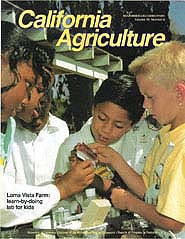


University of California
California Agriculture



|
|||
|
|||

Loma Vista Farm: learn-by-doing lab for kids
Cover:
On a visit to Loma Vista Farm, Vallejo School district students conduct tests of soil acidity – part of a lesson on sustainable agriculture. Cover photo by Jack Kelly Clark
November-December 1991
Volume 45, Number 6 News and opinion |
|||
|
University of California, 1301 S. 46th St., Bldg. 478 Richmond, CA
|